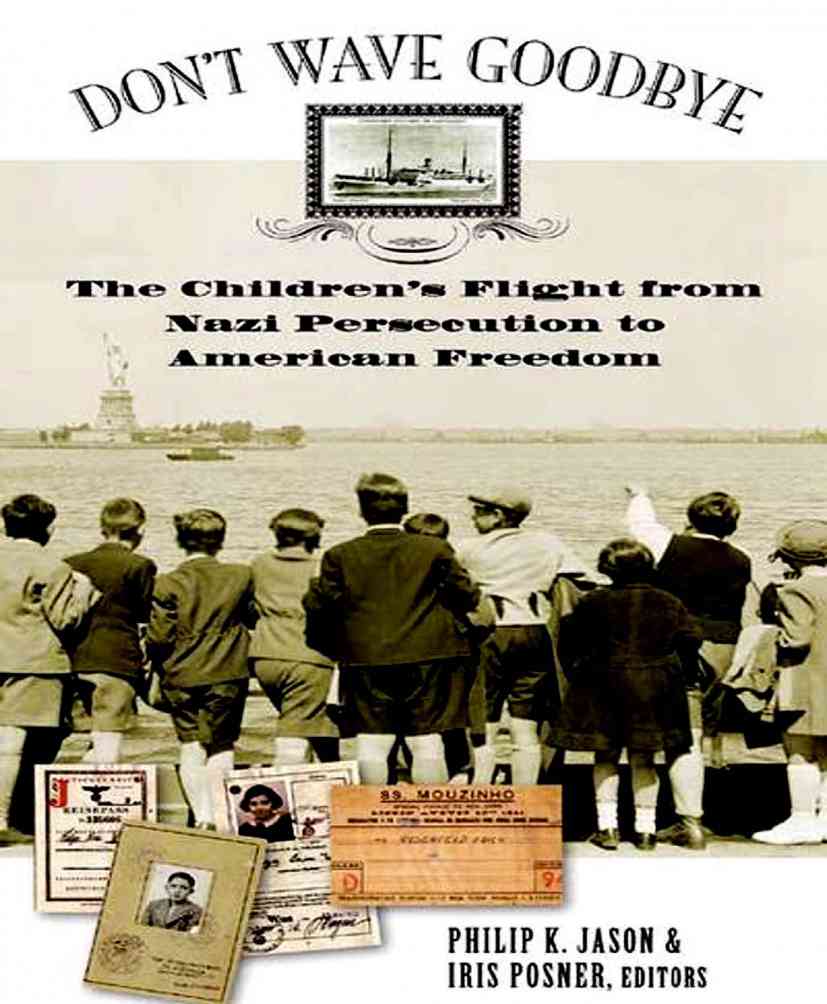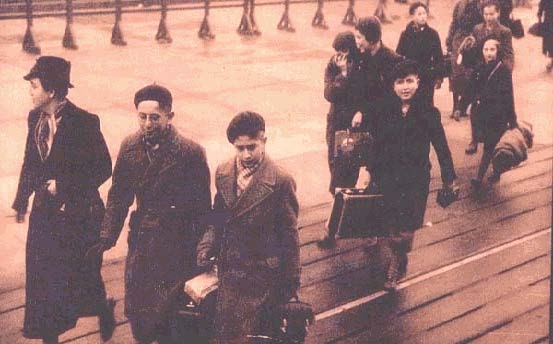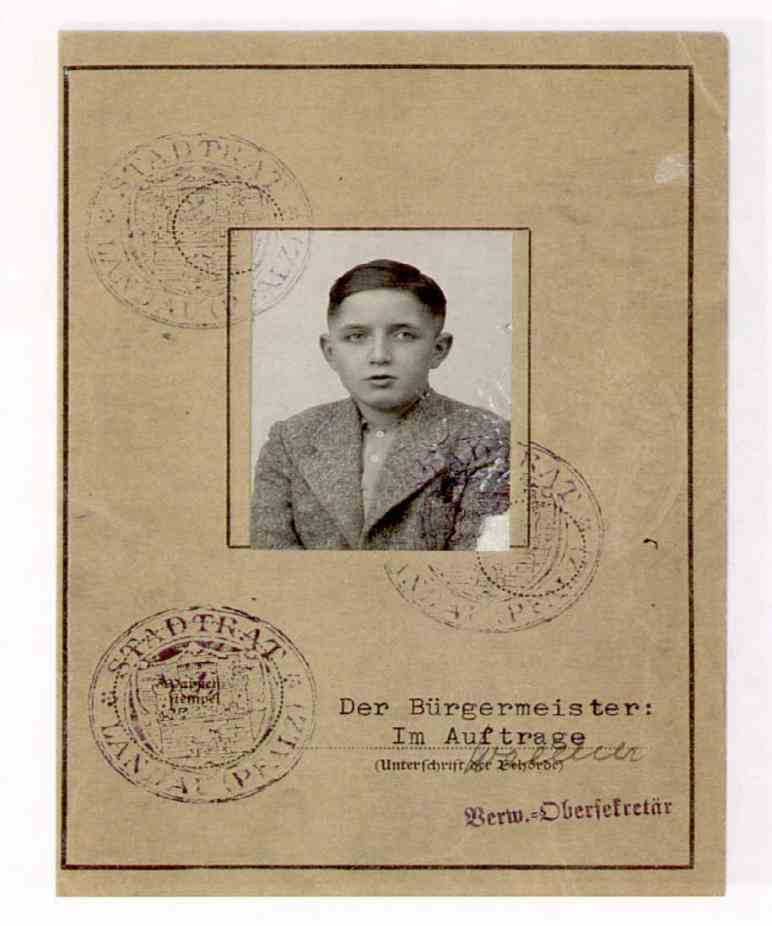Text from the OTC Brochure

"THE ONE THOUSAND CHILDREN" (OTC)
THE NETWORK OF COOPERATION THAT SAVED THEM
and their Organization: One Thousand Children Inc. (OTC)
In 1938, Manfred's parents, fearing the growing terror that was to become known as the Holocaust, arranged for their only child to be sent to America. He was thirteen years old. In his diary about the voyage to freedom, which Manfred Goldwein sent to his parents, he wrote, "I hope that you will be over here soon. But meanwhile, may G-d bless you and keep you in good health. May He free you very soon .... so that we may be together in a country that is too great to describe."
In 1946, still not knowing the fate of his parents, Manfred searched for them in his hometown of Korbach, Germany. A gentile neighbor had something for him. At risk to her own life, she had hidden Manfred's diary and his parents? last letters to him. His mother had written, "I know that you and all the dear ones over there have done all to save us, but fate decided otherwise .... Don't forget us, my dear son, as we shall never forget you. Farewell, my dear child. I hug and kiss you. Your mother!" His father, a Rabbi wrote, "You must not be sad, for we are in G-d's dear Hand and really in G-d's own land. I love you for ever and ever." Manfred, later to become a distinguished American physician and teacher, had learned the fate of his parents, victims of Nazi persecution that had ended for them in Auschwitz.
This is the story of "The One Thousand Children" (OTC) (the number has since risen to about 1,400). While a generation of 1.5 million children perished in the Holocaust, approximately 1,400 children -- like Manfred -- were brought to America in quiet operations designed to avoid a backlash from isolationist and anti-Semitic forces that could prevent these rescues. These rescues were funded and carried out by private citizens, organizations, and by hundreds of volunteers. The rescue operations spanned three continents, two oceans and twelve years from 1934 to 1945. They brought children, from fourteen months old through the age of sixteen, to the U.S. and placed them in foster families, with relatives, and in schools and facilities across America. There they waited for the time when they could be reunited with their own families. Tragically nearly all the children lost both parents and most of their extended families by the time the war had ended.
This story of triumph within tragedy is virtually unknown. Many of the children themselves (most now in their seventies and eighties) are unaware that they were part of organized efforts to bring to America as many children as possible threatened by Nazi persecution. Few Americans, and even historians, know the details of the powerful economic, social, political, religious and governmental constraints that had to be overcome. Only one scholar has published a book about the One Thousand Children which fully examines the complex interplay of factors that resulted in the rescue of about 1,400 mostly Jewish children. Unfulfilled Promise by Professor Judith Baumel, Ph.D., was published in 1990 by the littleknown Denali Press ( Juneau, Alaska).
Richard Schifter was an only child. Determined that their son must survive, his parents sent him to America in 1938, where he soon learned English, graduated first in his high school class, and second in his college class at the City College of New York (CCNY). He fulfilled his life's dream when he became an American Ambassador and Special Assistant to the American President. Unable to save his own parents from the catastrophe of the Holocaust, he worked to get Jews out of Russia and told them, "I didn't get my parents out, but I won't fail you." And he didn't.

The first small group of children arrived in New York in November 1934, and were placed in foster homes. In the early years many small groups (totaling about 100 annually) were also placed in foster homes. Many of these homes were arranged through appeals to congregations and organizations. Prior to 1941, only small groups were brought, because there was hostility to allowing foreigners to enter the U.S. during the Depression. Sponsors wanted to avoid drawing undue attention to the children, whose number also was limited to quotas for their countries of origin. In late 1938, when Kristallnacht convinced even the most naïve and optimistic European parents that the destruction of the Jews was the true Nazi agenda, the demand on these organizations increased markedly. However, U. S. policy as well as practical limitations frustrated that up-swell of panic. In the later period of 1941-42, when news of Nazi terrors was more widely circulated, larger groups arrived. Foster families in the U.S. agreed to care for the children until age twenty-one, see that they were educated, and guarantee that they would not become public charges. Most of the children were assigned a social worker from a local social service agency to oversee the child's resettlement process. Jewish children were placed in Jewish homes.
In 1934, Jack Steinberger (aged 13) and his bother were sent to America by their parents, who feared for the future in a Nazi Germany. (Jack's parents rejoined them in 1937.) After Jack graduated from high school, he worked in the family delicatessen to earn the money to attend college, where he studied chemical engineering and then physics. In 1988, Jack and two colleagues won the Nobel Prize in Physics for the discovery of a new nuclear particle.
Several dozen organizations played important roles in bringing these OTC children to freedom, including theGerman Jewish Children's Aid (GJCA), the American Jewish Joint Distribution Committee (the Joint), the National Council of Jewish Women (NCJW), the Hebrew Immigrant Aid Society (HIAS), the American Jewish Committee, the American Jewish Congress, B'nai B'rith, the American Friends Service Committee (the Quakers), the Unitarian Universalist Service Committee (UUSC), the United States Committee for the Care of Refugee Children (USC), the National Coordinating Committee, the National Refugee Service; also Brith Sholom Synagogue, and the Clara De Hirsch Home in New York. European organizations included the French Oeuvre de Secours aux Enfants (OSE) and the Kinderauswanderung Department of the Central Organization of German Jews in Germany.
His memorial service was attended both by thousands of ordinary people, and those famous in the world of Rock and Roll. He was Bill Graham, the legendary impresario and a father of the modern American Rock music business, who launched such icons as Otis Redding, Jefferson Airplane and the Grateful Dead. He was born Wolfgang Grajonca in Berlin, and at the age of eleven was brought to America to stay with a foster family in N.Y.C.

Even more noteworthy are the many many individuals who were involved in these multiple heroic efforts, often in an arduous and politically delicate situation. They sought out the OTC children in their homelands, arranged immigration and financial matters, and found transit-housing and permanent foster-homes. They gathered the OTC groups and escorted the individual groups on shipboard and to their final destinations. Some individuals were based in Germany and coordinated with other overseas Jewish Refugee organizations, often under the watchful eyes of the Nazis. They founded, participated in, obtained funding for, and staffed organizations that could help in these efforts, in America and in Europe and elsewhere. Far too many of these individuals have remained anonymous. Here we briefly only name Dr. Gabrielle Kaufmann, Cecilia Razovsky, Kate Rosenheim and Herta Souhami, Joseph Chamberlain, Eleanor Roosevelt, Marshall Field III, Lotte Marcuse, Martha Cogan, and Gilbert and Eleanore Kraus. Importantly, the American and European escorts, often women, who traveled back and forth at great risk to bring the children from Europe to America. And, most important of all, the families that let their children go, and the American families, related and not, who provided care and shelter to OTC children. And the children themselves!
Werner Michel arrived in America at age twelve with no knowledge of English, and so was initially placed in kindergarten. He became a career officer, served in three wars, was Director of Counterintelligence and Security at the Defense Intelligence Agency, and then Assistant to the Secretary of Defense for Intelligence Oversight with responsibility for oversight of all Department of Defense intelligence and counterintelligence activities worldwide.
In the U.S.A. OTC children lived with foster families, schoolmates and teachers, some of whom were supportive, and some not supportive at all. They had to live without knowing the whereabouts or well-being their families. (After the war, most learned that their parents had been murdered by the Nazis.) They were declared refugees of enemy countries (though later many were drafted into or volunteered for the armed forces and sent back overseas). Even so, most quickly adjusted and assimilated into American culture and society. OTC children became teachers, businessmen, scientists, a Nobel laureate, doctors, lawyers, career military officers, statesmen, scholars, a rock and roll impresario, artists, writers, publishers. They became loyal citizens and loving parents. They created their legacies through the contributions of their work and lives. They followed the path that Manfred's father spoke of, in his last letter to his son:
"I want you to walk His ways. You are a link of the long chain that began in the past and reaches into eternity. Be a worthy man."
In 2000 the nonprofit organization, One Thousand Children®, Inc. (OTC) was founded by Iris Posner and Leonore Moskowitz. Its mission is to "discover" and locate OTC children and the individuals and organizations that made rescue and resettlement of the OTC children possible; and to make this story part of the fabric of the world's historical record. OTC has identified 1400 OTC children and located about 600; has established an extensive website www.OneThousandChildren.Org , conducted and supported scholarly research and publication; has established an archive dedicated to the OTC history at the YIVO Institute in New York, and its artifacts are at the National Museum of American Jewish History (NMAJH). Posner and Moskowitz, through OTC, went on to organize the 2002 International Conference of OTC Children and Rescuers. Here many "children" first realized they were part of a piece of history. In 2004, a unique anthology was published: "Don't Wave Goodbye," edited by Philip Jason and Iris Posner (Greenwood), It presents over three dozen memoirs, documents, and photographs of OTC'ers, their rescuers, and second generation OTC'ers, and provides many first-person accounts of this unknown OTC story of tragedy and triumph.





